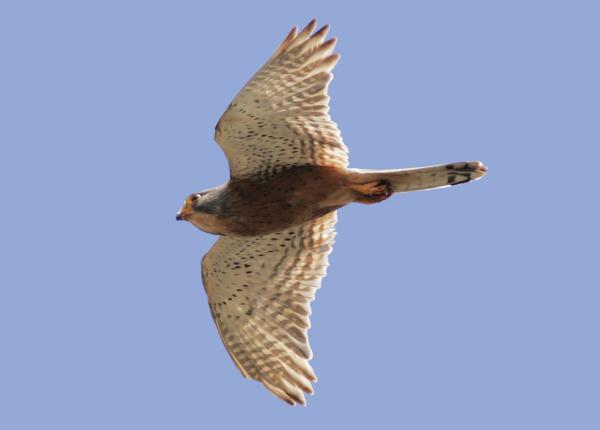Did You Know?
- In the past, the Rock Kestrel was considered a subspecies of the Common Kestrel.
- The Rock Kestrel is generally monogamous, meaning the same male and female will remain together for life.
How The Peregrine Fund is Helping
Though The Peregrine Fund does not work directly with the Jungle Owlet, our efforts in scientific research, habitat conservation, education, and community development help conserve raptors around the world. We also supply literature to researchers from our avian research library, which helps scientists around the world gather and share important information on raptor conservation. Additionally, our support of the Global Raptor Information Network gives raptor researchers tools to more efficiently conduct their own studies while contributing to a global program. It also provides citizen scientists a way to participate in raptor science and conservation.
Where They Live
The Rock Kestrel is found in southern Africa and can be found in northern Angola, Democratic Republic of Congo, Tanzania and South Africa, among others. It makes its home in a wide variety of open habitats but shows a particular preference for mountainous, hilly, and rocky areas. It can be found in shrub areas, grasslands, steppes, wetlands and semi-arid areas. It es even known to frequent small villages and large cities. Requires suitable sites on which to perch and roost, e.g. trees, telegraph poles, buildings, rock faces.
What They Do
If you find yourself in Rock Kestrel habitat, be sure to scan the power poles and wires, tall buildings, trees, rock faces, and mine rock dumps where it likes to perch.
Why They Need our Help
Thankfully, the Rock Kestrel is categorized as a species of Least Concern. It is one of the more common kestrels throughout its range.
What They Eat
The Rock Kestrel has quite a varied diet. It will feed on small mammals such as mice, voles, and shrews. It will also takes a wide variety of small birds, rodents, and reptiles, including snakes, as well as large insects such as beetles, grasshoppers, and crickets. It often hunts by hovering low above the ground, or from a perch on a snag or telephone pole or wire, plunging or parachuting down to capture prey on the ground.
Nests, Eggs, and Young
Like other falcon species, the Rock Kestrel does not build its own nests. Instead, the female will lay her eggs in cavities on rock cliffs, on ledges, in old nests built by other birds, on buildings, in nest boxes and even in baskets. The female may lay between 1-7 eggs, which must be incubated for around 30 days. When the nestlings are very young, the female will generally stay close to the nest to protect her offspring, while the male works hard to bring enough food to feed himself and his growing family. After around 5 weeks after hatching, the young kestrels will be ready to fly from the nest for the first time!
Rock Kestrels and the World Center for Birds of Prey
A visit to the World Center for Birds of Prey will provide you with a chance to learn all about different birds of prey. Though we are far away from the Rock Kestrel's range, our knowledgeable staff is on hand to answer any questions you may have about this, or any other raptor. A visit to our interpretive center is also a great way to learn more about kestrels in general. Examine kestrel feathers at the touch table, and compare the size of a kestrel egg with that of an ostrich. If you walk the interpretive nature trail to the gazebo overlooking the Boise Valley, you are likely to see a kestrel hovering over the sage in search of prey or, if you are lucky, a young bird just learning to fly might be fledging from a nearby nest box. We have an American Kestrel on our Avian Ambassador team, as well. This is a great opportunity to see one of these beautiful birds up close.
References:
Global Raptor Information Network. 2022. Species account: Rock Kestrel Falco rupicolus. Downloaded from http://www.globalraptors.org on 12 Nov. 2022
Groombridge, J.J. (2002). "A molecular phylogeny of African kestrels with reference to divergence across the Indian Ocean." Molecular Phylogenetics and Evolution. 25: 267–277. doi:10.1016/s1055-7903(02)00254-3. PMID 12414309.
Orta, J., P. F. D. Boesman, and J. S. Marks (2020). Rock Kestrel (Falco rupicolus), version 1.0. In Birds of the World (S. M. Billerman, B. K. Keeney, P. G. Rodewald, and T. S. Schulenberg, Editors). Cornell Lab of Ornithology, Ithaca, NY, USA. https://doi.org/10.2173/bow.eurkes1.01









